Important Questions for Class 12 History Chapter 11 – 4 Marks Questions
Question 1.
Examine how Lord Dalhousie’s policy of annexation created dissatisfaction amongst the people of Awadh. (Delhi 2016)
or
Critically examine Lord Dalhousie’s policy of annexation in Awadh. (HOTS; All India 2015)
or
How did British dispossess Taluqdars of Awadh during 1857. Explain with examples. (Delhi 2014)
or
“The annexation of Awadh displaced not just the Nawab, but also dispossessed the taluqdars of the region, causing breakdown of an entire social order.” Critically examine the statement. (HOTS: Delhi 2010)
Answer:
The Nawab of Awadh had been loyal to the British East India Company from the very beginning. But, the loyalty of Awadh was of no significance to Lord Dalhousie’s imperialistic ambitions. Awadh could not be annexed on the basis of the Doctrine of Lapse as Wajid Ali Shah, as the Nawab of Awadh had several successors. So, the British especially Lord Dalhousie used a number of mischievous tricks to annex the Awadh and dispossessed the taluqdars.
These were:
- On 13th February, 1856, Awadh was annexed to the British empire on the grounds of maladministration.
- Nawab Wajid Ali Sahib was sent to Calcutta with an annual pension of ₹ 12 lakh. With the dissolution of the royal administration, large number of courtiers, officials and taluqdars became jobless.
- Jagirs of taluqdars were confiscated. This upheaval was aggravated by immediate material losses.
- The British were not willing to tolerate the power of the taluqdars.
- With the removal of Nawab, all taluqdars of the Awadh were also dispossessed, taluqdars were disarmed and their forts were destroyed.
- With a new revenue system i.e. Summary Settlement, taluqdars lost their very large share of revenue from land. Wherever possible, taluqdars were removed and settlement was done directly with peasant.
- British believed that this would increase the flow of revenue to the company and peasants would also be freed from oppression of taluqdar. This annexation of Awadh meant complete break down of social order.
Question 2.
With the help of specific examples examine the nature of Indian leadership that emerged against British in the revolt of 1857. (All India 2016)
Answer:
During the revolt few leaders participated very enthusiastically while some other participated because they had no choice. They had to participate in the revolt for the sake of their reputation.
For e.g. Bahadur Shah was reluctant to join the rebellion but due to demands of sepoys, he joined the revolt and it was fought under his name. Similarly, sepoys and people of Kanpur choose
Nana Sahib as their leader and he joined the revolt.
Rani Lakshmibai of Jhansi participated because her kingdom had been annexed to empire by ‘Doctrine of Lapse’ and there was also popular pressure on her to take the leadership. In Awadh, their was deep resentment against annexation, dispossession of nawab and oppressive rule of British. People of Awadh declared Birjis Qadr, the young son of dispossessed Nawab as their leader.
Apart from the royal families, local leaders also emerged during the revolt like Kunwar Singh in Arrah, fakir in Lucknow, Shah Mai in Baraut and Gonoo, a tribal cultivator in Singhbhum. Although the leaders of 1857 revolt participated in this war, but they had separate goals which made the revolt unsuccessful against British.
Question 3.
Examine the repressive measures
adopted by British to subdue the rebels of 1857. (All India 2015)
Answer:
It was not easy for the Britishers to suppress the revolt. Even then they took various steps to crush the rebels.
These steps were as follows:
Passing of Laws to help the Troops:
The British passed several laws to help the troops before sending them to re-occupy North India. The military officers were also empowered to try and punish the rebel Indians. The ordinary process of law and trial were ignored by them.
With the help of new laws and the new reinforcements coming from Britain, the ‘ British started the process of suppressing the revolt. British thought to reconquer Delhi was most important to suppress the revolt. Therefore, in June 1857, the British attacked Delhi from two directions. Captain Hudson arrested the Mughal Emperor Bahadur Shah II and Begum Zinat Mahal from the Tomb of Humayun on 21st September, 1857.
Resorting to Diplomacy:
The British while resorting to diplomacy kept away the educated Indians and zamindars from the rebels. The British created a rift between rebels and the zamindars by promising the latter to give back their estates.
Use of Military Power on a Gigantic Scale:
The British used military power on a gigantic scale. But, this held their absolute control over the means of communication. Their control over the railways enabled them to send quick military support to different parts of the country’.
Communication System:
The telegraph system helped the British to get timely information about the incidents occurring in different parts of the country. Consequently, they were successful in wrecking plans of the rebels by taking immediate action against them. Thus, the British tried their best to maintain their absolute control over the means of communication in order to suppress the revolt.
Question 4.
Examine the provisions of ‘Subsidiary Alliance System’ devised by Lord Wellesley in 1798 for India. (All India 2015)
or
Explain the provisions of the Subsidiary Alliance imposed on Awadh in 1801 by the British. (Delhi 2012)
Answer:
The Subsidiary Alliance was introduced by Lord Wellesley in 1798. All those who entered into such an alliance with the British had to accept certain terms and conditions.
These were:
- The British would be responsible for protecting their ally from external and internal threats to their power.
- In the territory of the ally, a British armed contingent would be stationed.
- The ally would have to provide the resources for maintaining this contingent.
- The ally could enter into agreements with other rulers or engage in warfare only with the permission of the British.
Question 5.
“The relationship of the sepoys with the superior white officers underwent a significant change in the years preceding the uprising of 1857”. Support the statement with examples. (All India 2014)
or
How did the white officers make it a point, during the 1820s till 1840s to maintain friendly relations with the sepoys? Describe briefly. (All India 2012)
Answer:
The white officers made it a point during the 1820s till 1840s to maintain friendly relations with the sepoys.
These were as follows:
- Several white officers could speak in Hindustani easily and were also familiar with the culture and traditions of the country.
- The relationship of sepoys with their British officials underwent significant change. In the decade of 1820, British officers stressed on maintaining friendly relations with the sepoys.
- Prior to the revolt of 1857, the relationship of the sepoys with white officers made it a point to keep friendly relationship with the sepoys. They would actively took part in their leisure activities.
- Despite this in the 1840s, the balance of mutual relationship changed drastically. The white officers created a sense of superiority and started keeping the sepoys as their racial inferiors.
- The equation of superior and inferior changed the whole script of mutual relationship. The elements of abuse and physical violence became routine activities. Consequently, the distance between sepoys and officers became wider. Due to this, mutual suspicion cropped up.
Question 6.
How did the rebels in 1857 try to materialise their vision of unity? Explain briefly. (HOTS; Delhi 2010)
Answer:
The revolt tried to garner the support of all sections of the society irrespective of their caste and creed. The rebellion was viewed as a war in which both the communities as Hindus and Muslims stood equally to gain and lose. The amicable relations which existed between the two communities were emphasised. The ishtehari brought to the forefront memories of the pre-British Hindu-Muslim past and glorified the coexistence of different communities under the Mughal Empire.
Thus, religious differences were not visible between the two communities in 1857 despite British attempts to create a wedge between them. Through this way, they tried to materialise their vision of unity.
Question 7.
“The rumours in 1857 began to make sense when seen in the context of the policies pursued by the British from late 1820s”. Support your answer with evidence. (Delhi 2009)
Answer:
The rumours in 1857 that made sense in context of the policies pursued by the British from late 1820s were as follows:
- During the Governor-Generalship of Lord William Bentinck some specific policies were adopted in order to ‘reform’ Indian society by the introduction of Western education. Western ideas and Western institutions.
- Reforms like the abolition of Sati System.
- Annexation of Jhansi and Satara-British refused to recognise adoption.
- Reforms like Widow re-marriage Act.
- Reforming socio-religious customs like land holding, inheritance, etc.
- Rumours had an impact on the minds of people under these uncertain times.
The common Indians looked at all these steps with apprehension and suspicion.
Visual images and literature as much as the writing of history have helped in keeping alive the memory of the revolt of 1857.” Assess this statement. (All India 2008)
Question 8.
Describe how the British celebrated those, 9. whom they believed saved the English and repressed the rebels during the Revolt of 1857? (Delhi 2008)
Answer:
The British celebrated those whom they believed saved the English and repressed the rebels during the revolt of 1857 by the various types of paintings which were meant to provide a range of different emotions and reactions also.
In an example of this type, ‘Relief of Lucknow’, which has been painted by Thomas Jones Barker in 1859 is particularly remarkable in this regard.
Henry Lawrence, the Commissioner of Lucknow, gathered all the Christians and took refuge along with them in heavily fortified residency after the rebel forces besieged Lucknow.
Lawrence was killed, but the residency continued to be defended under the command of Colonel Inglis. On 25th September, James Outram and Henry Havelock arrived out through the rebel forces and reinforced the British Garrisons. Collin Campbell reached with huge reinforcements and rescued the besieged British Garrison. In British accounts, the siege of Lucknow became a story of survival heroic resistance and the ultimate triumph of British power.
The arrival of Collin Campbell has been depicted as an event of celebration in Jones Barker’s painting. Campbell, Havelock and Outram, the three British heroes have been painted in the middle of the canvas.
The victorious figures of the heroes in the middle symbolise the re-establishment of British power and control is the main objective of these paintings and was to reassure the English in the power of their government. These paintings clearly conveyed the message that crisis was over and the revolt had been quelled and the British had succeeded in re-establishment of their power and authority.
Question 9.
Visual images and literature as much as the writing of history have helped in keeping alive the memory of the revolt of 1857.” Assess this statement. (All India 2008)
Answer:
The writing of history, art and literature contributed remarkably to immortalise the sacred memory of the struggle of 1857. The leaders of revolt were presented as heroes taking the country towards the battlefield. They were depicted as heroes inspiring the common masses to begin struggle against the oppressive colonial power.
Many heroic poems were composed narrating the bravery of Laxmi Bai, holding a sword in one hand and the reins of the horse in the other, fought for the independence of her motherland. She was usually portrayed in battle armour with a sword in hand and riding a horse symbolising the determination to resist injustice and alien rule.
Thus, it becomes clear that visual representations produced various images of the revolt. We should know that these images were not a mere expression of contemporary ideas and sentiments, but they also reflected the contemporary sensibilities.
Important Questions for Class 12 History Chapter 11 – 8 Marks Questions
Question 10.
“Rumours and prophecies played a part in moving the people into action during the revolt of 1857.” Examine the statement with rumours and reasons for its belief. (All India 2017)
Answer:
It is true that rumours and prophecies played a part in moving people to action during the revolt of 1857.
These rumours were as follows:
1. During 1857 revolt, there was an apparent rumour that the Indian sepoys were intentionally given the Enfield rifles, and its bullets were coated with the fat of cows and pigs and biting those bullets would corrupt their caste and religion.
2. The British tried to explain to the sepoys that this was not the case but the rumour that the new cartridges were greased with the fat of cows and pigs which spread like wildfire across the sepoy lines of North India.
3. This is one rumour whose origin can be traced. Captain Wright, commandant of the Rifle Instruction Depot, reported that in the third week of January 1857 a ‘low-caste’ Khalasi who worked in the magazine in Dum Dum had asked a Brahmin sepoy for a drink of water from his lota. The sepoy had refused saying that the Tower caste’s’ touch would defile the lota. The Khalasi had reportedly retorted, “You will lose your caste, as ere long you will have to bite cartridges covered with the fat of cows and pigs”.
4. The truthfulness of the report had not identified but once this rumour started no amount of assurances from British officers could stop its circulation and the fear of it spread among the sepoys.
5. This was not the only rumour that was circulating in North India at the beginning of 1857. There was the rumour that the British government has hatched a gigantic conspiracy to destroy the caste and religion of Hindus and Muslims.
It is seen that rumours reflect about the minds of people who believed them, their fears and apprehensions, their faiths and convictions. Rumours circulate only when they resonate with the deeper fears and suspicions of people. The rumours in 1857 begin to make sense when seen in the context of the policies the British pursued from the late 1820s. The reasons of believing in these rumours are discussed below:
- From that time under the leadership of Governor General Lord William Bentinck, the British adopted policies aimed at ‘reforming’ Indian society by introducing Western education,Western ideas and Western institutions. With the cooperation of sections of Indian society they set up English-medium schools, colleges and universities which taught Westerp sciences and the liberal arts.
- The British established laws to abolish customs like sati (1829) and to permit the remarriage of Hindu widows.
- The British annexed not only Awadh, but also Jhansi and Satara. Once these territories were annexed, the British introduced their own system of administration. The impact of this on the people of North India was profound.
- It seemed to the people that all that they cherished and held sacred from kings and socio-religious customs to patterns of landholding and revenue payment was being destroyed and replaced by a system that was more impersonal, alien and oppressive.
- This perception was aggravated by the activities of Christian missionaries. In such a situation of uncertainty, rumours spread with remarkable swiftness. And people started to believe in these rumours during the revolt of 1857.
Question 11.
Examine the visual representations of the revolt of 1857 that provoked a range of different emotions and reactions.
(All India 2017)
Am There are a number of visual representations of the revolt of 1857 like paintings, pencil drawings, etchings, posters, cartoons, bazaar prints, etc which were produced by the British and Indian artists and painters. These are discussed below:
1. British pictures offers a variety of images that were meant to provoke a range of different emotions and reactions. Some of them commemorate the British heroes who saved the English and repressed the rebels. For e.g. ‘Relief of Lucknow’, painted by Thomas Jones Barker in 1859 depicts the efforts of James Outram, Henry Havelock and Colin Campbell in rescuing the besieged British garrison in Lucknow.
2. Newspaper reports have a power over public imagination. This reported about the incidence of violence against women and children and raised a public demand in Britain for revenge and retribution. Artists expressed as well as shaped these sentiments through their visual representations of trauma and suffering.
3. “In Memoriam” was painted by Joseph Noel Paton in which English women and children huddled in a circle, looking helpless and innocent seemingly waiting for the inevitable dishonor, violence and death coming from the rebels. This represents the rebels as violent and brutish.
4. In another set of sketches and paintings women are seen in a different light. They appear heroic, defending themselves against the attack of rebels, for e.g. a painting depicts Miss Wheeler who stands firmly at the centre, defending her honour, single-handedly killing the attacking rebels. This picture is represented as having a deeper religious connotation. It is a battle to save the honour of Christianity and the book lying on the floor is the Bible.
5. As waves of anger and shock spread in Britain, demands for retribution grew louder. Threatened by the rebellion, the British felt that they had to demonstrate their invincibility.
For e.g. in an image an allegorical female figure of justice with a sword in one hand and a shield in the other is seen. Her posture is aggressive, her face expresses rage and the desire for revenge. She is trampling sepoys under her feet while a mass of Indian women with children cower with fear.
6. When Governor General Canning declared that a gesture of Leniency, he w’as mocked in the British press. In a British Journal of comic satire, Canning is shown as a looming father figure, with his protective hand over the head of a sepoy who still holds sword and dagger in hands, both dripping with blood.
7. On the other hand leaders of the revolt were presented as heroic figures leading the country into battle, rousing the people to righteous indignation against oppressive imperial rule. For e.g. Rani of Jhansi was represented as in popular prints a masculine figure chasing the enemy slaying British soldiers and valiantly fighting till her last. She is usually portrayed in battle armour, with a sword in hand and riding a horse, a symbol of the determination to resist injustice and alien rule.
Question 12.
‘A chain of grievances in Awadh linked the prince, taluqdars, peasants and sepoy to join hands in the revolt of 1857 against the British”. Examine the statement. (All India 2017)
Answer:
Since 1800 century, Awadh faced a number of grievances which linked the princes, taluqdars, peasants and sepoys to join hands in the revolt of 1857 against the British. The British wanted to annex Awadh in their empire. This conquest happened in stages which were:
Annexation of Awadh:
The Subsidiary Alliance had been imposed on Awadh in 1801, which confined the power of the Nawab over his territory as his military force disbanded, the British troops took position in the kingdom and he could not take any decision without the advice of the British resident who was attached to the court of Awadh. He could no longer assert control over the rebellious chiefs and taluqdars. The British became increasingly interested in acquiring the territory of Awadh as it was economically and geographically important for them.
By the early 1850s, all the major areas of India, e.g. Maratha land, Doab, the Carnatic, the Punjab and Bengal had been conquered by the British. By annexation policy Nawab Wajid Ali Shah (Awadh) was dethroned and exiled to Calcutta on the plea that the region was being misgoverned.
The emotional upheaval was aggravated by immediate material losses, e.g. it led cultural loss as well as many people lost their livelihood.
Dispossession of Taluqdars:
This annexation also dispossessed the taluqdars of the region. Before the advent of the British, they were powerful and maintained armed retainers, built forts and enjoyed degree of autonomy. The British were unwilling to tolerate the power of taluqdars. Immediately after the annexation, the taluqdars were disarmed and their forts destroyed. The first revenue settlement, known as the ‘Summary Settlement’, further undermined the position and authority of the taluqdars. This settlement proceeded to remove the taluqdars wherever possible. The taluqdars of Southern Awadh were the hardest hit and some lost more than half of total number of villages.
Suppression over Peasants:
By removing the taluqdars, the British wanted to reduce the level of exploitation and increase the revenue demand, and end-up the rendition system.
But now, Peasants were in more difficult situation. Under the British rule there was no guarantee that in times of hardship or crop failure the revenue demand of the state would be reduced or collection postponed, or that in times of need they would get any loan or support that the taluqdar had earlier provided. Thus, with this suppression, neither taluqdars nor peasants had any reasons to be happy with the annexation.
Now, the situation was completely changed. Many taluqdars outside the Awadh who participated in the 1857 revolt were loyal to the Nawab of Awadh and they joined Begum Hazrat Mahal (the wife of Nawab) in Lucknow to fight the British. Peasants also took participate in the revolt.
Rage of Sepoys:
There was also a rage in sepoys towards the British. Before 1820, the British were very gentle with the sepoys but in 1840 this began to change. The officers developed sense of superiority and started treating the sepoys as their inferiors. Abuse and physical violence became common. Trust was replaced by suspicion. The episode of the greased cartridges was a classic example of this.
Most of the sepoys were from Awadh and Eastern Uttar Pradesh. Now, the fears of the sepoys about the new cartridges, their grievances about leave, their grouse about the increasing misbehavior and racial abuse on the part of their white officers were the responsible factors for their rage. A whole complex of emotions and issues, traditions and loyalties worked themselves out in the revolt of 1857. In Awadh, more than anywhere else, the revolt became an expression of popular resistance of an alien order.
Important Questions for Class 12 History Chapter 11 Map Based Question
Question 13.
On the given outline map of India locate and label the following appropriately.
(i) Masulipatnam a territory under British control during 1857.
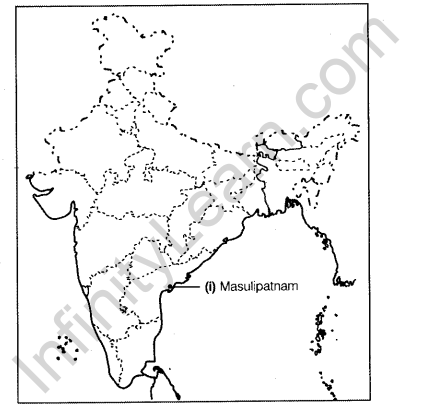
Question 14.
On the map 3 centres of the Revolt of 1857 have been marked as A, B and C. Identify them and write their names on the lines drawn near them. (All India 2015, 13, 12, Delhi 2011)
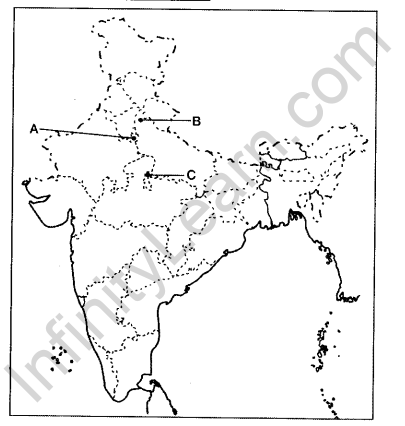
Answer:
A. Delhi
B. Meerut
C. Jhansi
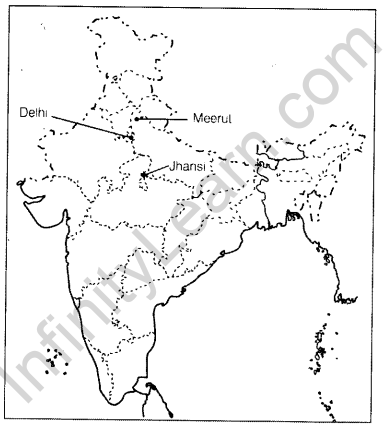
Question 15.
On the same political outline map of India three places related to the centres of the revolt of 1857 have been marked as A, B and C. Identify them and write their correct names on the lines drawn near them. (All India 2014)

A. Delhi
B. Lucknow
C. Varanasi
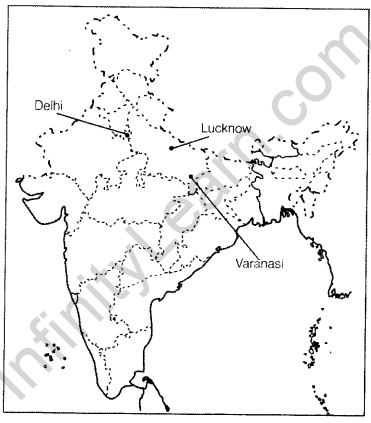
Question 16.
On the map 3 centres of the revolt of 1857 have been marked as A,B and C. Identify them and write their names on the lines drawn near them. (Delhi 2013, All India 2015, 2012)
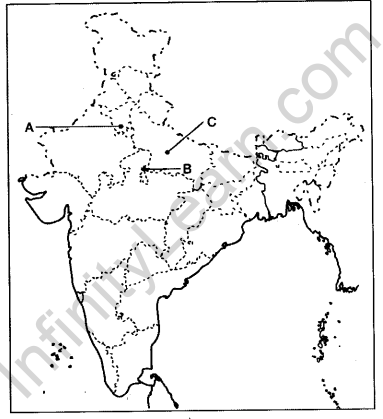
Answer:
A. Delhi
B. Jhansi
C. Lucknow
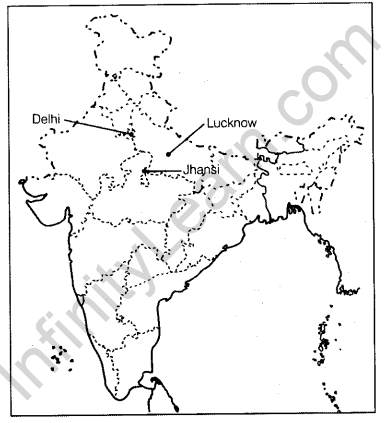
Question 17.
On the map 3 territories/cities under the British control in 1857 have been marked as A, B and C. Identify them and write their names on the lines drawn near them. (Delhi 2012)
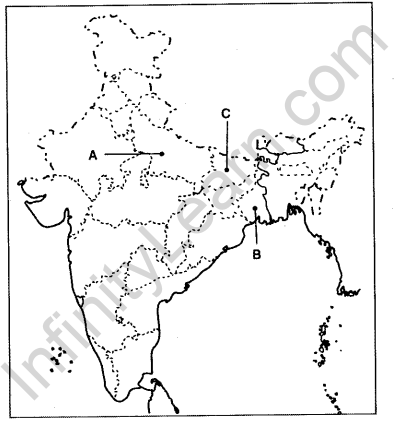
Answer:
A. Lucknow
B. Calcutta
C. Patna
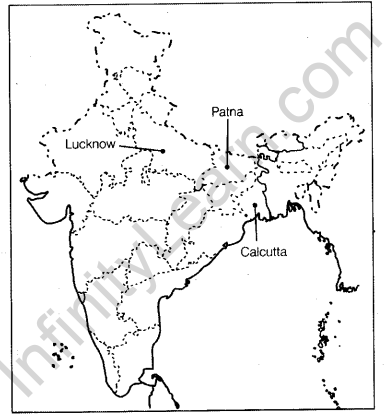
Question 18.
On the map 3 important centres of the revolt of 1857 have been marked as A, B and C. Identify them and write their names on the lines drawn near them. (All India 2012, Delhi 2009)
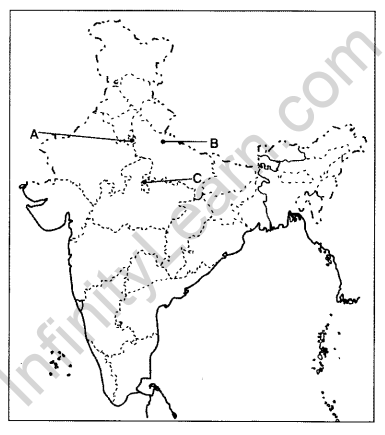
Answer:
A. Delhi
B. Bareilly
C. Jhansi

Important Questions for Class 12 History Chapter 11 Value Based Questions
Question 19.
“The nationalist movement in the 20th century drew its inspiration from the event of 1857. A whole world of nationalist was woven around revolt. It was celebrated as the first war of Independence in which all sections of the people of India come together to fight against imperial rule.”
1. “The revolt of 1857 marked first nationalist challenge to the English in India.” Explain by giving examples to the value imbibed and practiced by the rebels to set the beginning for it. (Delhi 2015)
Answer:
1. During the Revolt of 1857, there was strong sense of unity among people of different religion, caste and creed participated and fought equally without any distinction. The rebellion was seen as a war in which both Hindus and Muslims had equality to lose or gain. A deep respect was emerging for the leaders who sacrificed there lives for saving the society from oppressive rules of British government. British government tried to create cracks in the Hindu-Muslim unity but rebels successfully resisted this intention of British at that time.
Question 20.
- The Rebel Proclamation of 1857 emphasised the values of coexistence amongst different communities under Mughal Empire. Explain.
- Suggest two ways to bring peaceful coexistence and fraternity in the contemporary Indian society. (All India 2014)
Answer:
1. In 1857, the rebel proclamations repeatedly appealed to all the sections of population irrespective of their caste and creed. The rebellion was felt as a war, in which both Hindus and Muslims had equally to lose or gain.
2. Two ways to bring peaceful coexistence and fraternity in the contemporary Indian society are as follows:
- In the contemporary Indian society, we can develop a sense of peaceful coexistence and mutual fraternity through creating a sense of unity and harmony within communities,
- We need to condemn bigotry and establish a secular and democratic India for the coming generations.
Question 21.
Nawab Wajid Ali Shah was dethroned and exiled to Calcutta on the plea that the region was being misgoverned. The British Government also wrongly assumed that Wajid Ali Shah was an unpopular ruler.
On the contrary, he was widely loved and when he left his beloved Lucknow, there were many who followed him all the way to Kanpur, singing songs of lament.
The widespread sense of grief and loss at the Nawab’s exile was recorded by many contemporary observers. One of them wrote, “The life was gone out of the body and body of this town had been left lifeless… there was no street or market and house which did not wail out the cry of agony in separation of Jan-i-Alam.” One folk song bemoaned that “the honourable English came and took the country.’
- Why did people bemoan and show an emotional upheaval? Explain.
- What human values are revealed in the above passage? (Delhi 2013)
Ans.
1. British dethroned and exiled Nawab Wajid Ali Shah to Calcutta on the plea that the kingdom of Awadh was being misgoverned. Lord Dalhousie’s annexations of Awadh shocked and bewildered the people of Awadh.
The Nawab was loved, and respected by his people. The widespread sense of grief and loss at the Nawab’s exile was recorded by many contemporary observers. Everybody in the city felt sad and the city became lifeless without their king. Folk songs also lamented the separation of king.
2. The above passage reveals an emotional bond between the ruler and his subject.
It reflects their extensive love for the Nawab. When the Nawab was dethroned and exiled by the British, the people of Awadh felt as if their feelings had been mercilessly slaughtered.
This dethronement hurt their feelings and emotions and the sentimental bridge between the ruler and his subject was demolished by the British



